Assessment of ASX Clearing and Settlement Facilities Appendix B: Background Information
B.1 ASX Group Structure and Governance
There are two types of CS facilities operated by the ASX Group:
- CCPs. A CCP acts as the buyer to every seller, and the seller to every buyer in a market. It does so by interposing itself as the legal counterparty to all purchases and sales via a process known as novation. These arrangements provide substantial benefits to participants in terms of counterparty risk management as well as greater opportunities for netting of obligations. At the same time, however, they result in a significant concentration of risk in the CCP. This risk can crystallise if a participant defaults on its obligations to the CCP, since the CCP must continue to meet its obligations to all of the non-defaulting participants. The ASX CCPs manage this risk in a number of ways, including through participation requirements, margin collection, the maintenance of pooled resources and loss allocation arrangements (see Appendix B.3).
- SSFs. An SSF provides for the final settlement of securities transactions. Settlement involves transfer of the title to the security, as well as the transfer of cash. These functions are linked via appropriate delivery-versus-payment (DvP) arrangements incorporated within the settlement process.
The ASX Group operates two CCPs and two SSFs:
- ASX Clear provides CCP services for ASX-quoted cash equities, debt products and warrants traded on the ASX and Chi-X Australia Pty Ltd (Chi-X) markets, equity-related derivatives traded on the ASX market and Chi-X-quoted warrants traded on Chi-X. The provision of CCP services for Chi-X is provided under the Trade Acceptance Service (TAS), which allows ASX Clear to act as a CCP for trades executed on Approved Market Operator (AMO) platforms in accordance with the ASX Clear Operating Rules and Procedures.
- ASX Clear (Futures) provides CCP services for futures and options on interest rate, equity, energy and commodity products traded on the ASX 24 market, as well as AUD and NZD-denominated OTC interest rate derivatives (IRD).
- ASX Settlement provides SSF services for ASX-listed cash equities, debt products and warrants traded on the ASX and Chi-X markets. The provision of SSF services for Chi-X is provided under the TAS. Under the Settlement Facilitation Service, ASX Settlement provides DvP settlement services for transactions in non-ASX-listed securities undertaken on trading platforms operated by Approved Listing Market Operators; these include the National Stock Exchange of Australia and the Sydney Stock Exchange Limited. ASX Settlement also provides for subscriptions and redemptions in unlisted managed funds through the mFund Settlement Service.
- Austraclear provides settlement and depository services for debt securities, including government bonds. It also provides settlement services for derivatives traded on the ASX 24 market and for margin payments in ASX Clear and ASX Clear (Futures).
Each of the ASX facilities holds a CS facility licence, and each CCP and SSF is required under the Corporations Act to comply with the relevant FSS determined by the Bank (i.e. the CCP Standards and SSF Standards, respectively) and to do all other things necessary to reduce systemic risk (see Appendix B.2).
ASX Limited is the ultimate parent company of the four CS facilities (Figure 1) and is listed on the ASX market. The ASX Limited Board is responsible for overseeing the processes for identifying significant risks to ASX and ensuring that appropriate policies, as well as adequate control, monitoring and reporting mechanisms, are in place. In addition, the ASX Limited Board assigns certain responsibilities to subsidiaries within the group, including the boards of the four CS facilities (the CS Boards). The CS Boards are responsible for managing the particular clearing and settlement risks faced by each respective CS facility, including through compliance with the FSS. The CS Boards are subject to common governance arrangements with high-level objectives set out in the CS Boards' Charter. There are five directors that serve on all four CS Boards; one additional director serves on both the ASX Clear and ASX Settlement Boards and three additional directors serve on both the ASX Clear (Futures) and Austraclear Boards.

In the ASX corporate structure, the two CCPs – ASX Clear and ASX Clear (Futures) – are subsidiaries of ASXCC. ASXCC is the holding company for the two CCPs and manages the financial resources that the CCPs would use in the event of a default. It invests these resources according to a Treasury investment policy and investment mandate approved by the CS Boards. The two SSFs – ASX Settlement and Austraclear – are subsidiaries of ASX Settlement Corporation Limited. ASXCC and ASX Settlement Corporation Limited are in turn subsidiaries of the ASX Group's parent entity, ASX Limited. ASX Limited is the licensed operator of the ASX market, which provides a trading platform for ASX-quoted securities and equity derivatives. Another subsidiary, Australian Securities Exchange Limited, is the licensed operator of the ASX 24 market, an exchange for futures products.
In delivering their services, the CS facilities rely on group-wide operational and compliance resources held by ASX Operations Pty Limited (ASX Operations), a wholly owned subsidiary of ASX Limited. ASX Operations provides most operational resources required by the CS facilities.
ASX has adopted a group-wide organisational structure to manage the business operations of its various entities. Business units relevant to the CS facilities are organised into eight main groups:
- Office of the CEO
- Risk
- Operations
- Technology
- Business Development
- Office of General Counsel and Company Secretariat, and Regulatory Policy
- Finance
- Human Resources.
The CRO, who heads the Risk group, is responsible for providing executive oversight of ASX's Clearing Risk Policy Framework and Settlement Risk Policy Framework, which document the formal structure for the development, governance and review of policy and standards for the CCPs and SSFs.
The COO who heads the Operations and Technology groups, is responsible for providing executive oversight of the frontline management of risks under ASX's Settlement Risk Policy Framework. The COO is also responsible for the delivery of overall operations of the ASX Group and reports directly to the CEO, as does the CRO. Both COO and CRO have a direct reporting line to the CS Boards and are able to attend CS Board meetings.
The Risk and Operations groups contain a number of departments that play key roles in the management of risks faced by the CS facilities:
- Clearing Risk Quantification and Development (CRQD) is responsible for the development of clearing risk management systems, maintaining and validating CCP risk and pricing models and the implementation of CCP policies and standards.
- Clearing Risk Policy and Management (CRPM) develops and maintains CCP and SSF policies and standards.
- Post Trade Operations implements SSF policies and standards, and maintains effective procedures for carrying out those policies and standards.
- Enterprise Risk is responsible for enterprise-wide risk management, including general business risk.
- Enterprise Compliance oversees CS facility compliance obligations, including providing compliance training for business areas, undertaking compliance reviews, and coordinating reporting to regulators.
- Participants Compliance assesses new applications from potential CS participants and monitors existing participants for adherence with the CS facilities' rules.
- Internal Audit conducts risk-based reviews of internal controls and procedures across ASX. Internal Audit reports to the Audit and Risk Committee and to the CRO for administrative purposes only.
ASX has three main executive-level committees that support decisions related to the risk management of the CS facilities:
- The Risk Committee is responsible for advising the CRO on risk management decisions in the exercise of his delegated authority from the CEO.
- The Regulatory Committee is responsible for ASX policies related to the conduct and operations of the licensed entities in the ASX Group, including the CS facilities.
- The Technology, Operations and Security Committee (TOSC) is responsible for advising the COO in the oversight of ASX's technology, operations and security strategies, and the investments that support these strategies. A sub-group of the committee meets as the Portfolio Governance Group, providing oversight of significant projects within the ASX Group.
ASX's Executive Committee operates in parallel to the three executive-level committees described above. The Executive Committee reports to the ASX Limited Board and CS Boards on strategic and business initiatives, non-risk related frameworks and HR matters.
ASX also operates a number of other internal forums that bring together experts from departments across the group for the review or oversight of risk management at the CS facilities:
- Risk Quantification Working Group (RQWG) is responsible for quantitative risk management matters, such as the review and application of quantitative risk policies and standards. It also reviews material changes to the Model Validation Framework, including in relation to the oversight of model governance and the outcomes and recommendations of regular reviews of margining and stress test models. The RQWG is chaired by the CRO.
- Pricing and Valuations Working Group (PVWG) is primarily responsible for overseeing the policies and processes used for pricing and settlement. The coverage includes daily settlement prices and expiry prices for derivatives traded on ASX Trade and ASX 24, valuation of collateral held by ASXCC (on behalf of the ASX CCPs), and non-cash investments held by Group Treasury. The PVWG is chaired by the General Manager, CRQD.
- Default Management and Recovery Working Group (DMRWG) provides oversight of the CCP's DMRF. The DMRWG is chaired by the CRO.
- PIRG is responsible for monitoring and managing material participant incidents, including any non-compliance with participant obligations, settlement default, operational failure or an event which might result in the participant becoming an externally administered body corporate or an insolvent under administration and, in the case of a clearing participant, escalating potential default events to the DMC.
- The Technology Risk Working Group (TRWG) is responsible for the management of active and emerging technology risks, technology KRIs, COO risk report, and six-monthly risk profiles, with the outcomes being reported to the TOSC. The TRWG is chaired by the Chief Information Officer and meets quarterly.
- In addition to the internal forums that ASX operates, the views of participants and other stakeholders are sought through external standing forums:
- An ASX Clear (Futures) DMG which is comprised of OTC participants and is consulted on aspects of the default management process.
- RCCs for both ASX Clear and ASX Clear (Futures), comprising participants from each CCP. The committees are consulted on material changes to default management processes, the margining methodology, the default fund, position and liquidity limits, participation criteria, and other changes affecting risk management practices or related rules.
- A Business Committee which acts as a stakeholder advisory body for ASX's cash market clearing and settlement services. The Committee is comprised of representatives of clearing participants, settlement participants, AMOs, share registries and a number of relevant industry associations.
- Advisory user groups for particular products and services (i.e. ETOs, rates and Austraclear), which are forums for participants to provide feedback on those products and services.
B.2 Regulatory Environment
The Corporations Act establishes conditions for the licensing and operation of CS facilities in Australia and gives ASIC and the Bank powers and responsibilities relating to these facilities. These powers are exercised under the governance of ASIC's Commission and the Bank's Payments System Board, respectively. The regulators' respective roles are defined in the Corporations Act.
- The Bank is responsible for determining standards (the FSS) for the purposes of ensuring that CS facility licensees conduct their affairs in a way that causes or promotes overall stability in the Australian financial system, and for assessing how well a licensee is complying with its obligation under the Corporations Act, to the extent that it is reasonably practicable to do so, to comply with these standards and do all other things necessary to reduce systemic risk.
- ASIC is responsible for assessing the extent to which CS facility licensees comply with all other obligations of a CS facility licensee arising under the Corporations Act, including notably the obligation, to the extent that it is reasonably practicable, to do all things necessary to ensure that the CS facility's services are provided in a fair and effective way.
The Bank has determined two sets of FSS relevant to its oversight of CS facilities: the CCP Standards and SSF Standards.
As licensees, the ASX CS facilities are required to provide the Bank with timely information on any material developments relevant to the services provided under its CS facility licence and its compliance with the FSS. The Bank also gathers information on the facilities through an open and ongoing dialogue with ASX staff, including through scheduled periodic meetings and ad hoc targeted meetings on specific topics.[19] Based on the information gathered, the Bank undertakes regular assessments of the ASX CS facilities.
The ASX CCPs are recognised by European Securities and Markets Authority (ESMA) as ‘third-country CCPs’. This allows the ASX CCPs to continue to provide clearing services to participants established in the European Union (see section 3.5.1 regarding the withdrawal of the UK from the EU). ASX Clear (Futures) was also granted an exemption from registration as a Derivatives Clearing Organization in the US. This exemption allows ASX Clear (Futures) to provide clearing services to US banks with respect to ‘proprietary’ swaps. The Bank and ASIC have established a memorandum of understanding (MoU) with each of ESMA and US Commodity and Futures Trading Commission which, among other things, supports cross-border cooperation and information sharing. The Bank has also issued a supplementary interpretation of CCP Standards to facilitate the ASX CCPs' recognition in the EU (see Appendix C).
The Bank has an MoU with the RBNZ which establishes cooperation arrangements relevant to ASX Clear (Futures)' existing activities in NZD-denominated products. RBNZ has also stated that ASX Clear (Futures) may be of systemic importance in New Zealand and may therefore be designated for oversight as an offshore FMI under the RBNZ's proposed new oversight regime for FMIs.[20]
B.3 Risk Management in the ASX Central Counterparties
CCPs are exposed to both credit and liquidity risks, primarily following the default of one or more participants. Credit risk is the risk that one or more counterparties will not fulfil their obligations to the CCP, resulting in a financial loss, while liquidity risk arises where the CCP is unable to meet its payments obligations at the time that they are due, even if it has the ability to do so in the future. ASX Clear and ASX Clear (Futures) manage the risks arising from a potential default in a number of ways, including through participation requirements, margin collection, the maintenance of prefunded pooled financial resources, recovery tools, and risk monitoring and compliance activities.
Participation requirements
Participants in each CCP must meet minimum capital requirements. While capital is only a proxy for the overall financial standing of a participant, minimum capital requirements offer comfort that a participant has adequate resources to withstand an unexpected shock, for example, arising from operational or risk-control failings.
- ASX Clear requires direct participants that clear cash market products or derivatives to maintain at least $5 million in capital. ‘General participants’, which are able to clear on behalf of third-party participants, are subject to tiered capital requirements. A general participant must maintain $5 million in capital to support its own clearing activity and $5 million to support each third-party clearing relationship, up to a maximum of $20 million. These base capital requirements are supplemented by additional capital requirements that are designed to account for the complexity of each participant's business model. The additional capital requirements reflect each participant's activities in own-account business, non-ASX client activity, and client-written ETO activity. ASX applies an additional capital requirement of $2.5 million or $5 million for material activity in each of these areas, depending on the level of materiality. The total core capital requirement is capped at $35 million if the maximum level of additional capital requirements applies.
- ASX Clear (Futures) requires participants that clear futures only to hold at least $5 million in NTA. Participants using the OTC derivatives clearing service must meet a higher minimum NTA (or Tier 1 Capital) requirement of $50 million.
The CCPs also impose capital-based position limits (CBPLs) on participants' activity. Specifically, a participant's initial margin requirements cannot be more than three times the level of its liquid capital, NTA or Tier 1 Capital. Under certain conditions, banks and subsidiaries of banks or bank holding companies that are participants of ASX Clear (Futures) are not subject to a ratio-based limit. Rather, these institutions' initial margin liabilities are subject to a fixed $1.5 billion aggregate limit. If a participant exceeds its CBPL, it will be called for additional margin. ASX Clear also places requirements on participants to establish a formal liquidity risk management framework and prepare a twelve-month liquidity plan.
Prefunded financial resources
The CCPs cover their credit and liquidity exposures to their participants by collecting margin and maintaining a fixed quantity of prefunded pooled resources. The CCPs collect several types of margin.
- Variation margin. Variation (or ‘mark-to-market’) margin is collected at least daily from participants with mark-to-market losses and – in the case of futures, OTC derivatives and cash market contracts – paid out to the participants with mark-to-market gains.
- Initial margin. Both CCPs routinely collect initial margin from participants to mitigate credit risk arising from potential changes in the market value of a defaulting participant's open positions between the last settlement of variation margin and the close-out of these positions by the CCP. The CCPs use statistical models to calculate initial margin, which vary by product type. To validate the adequacy of their initial margin models, the CCPs perform regular backtesting and sensitivity analysis.
- AIM. The CCPs may also make calls for AIM when exceptionally large or concentrated exposures are identified, including through stress tests, or when predefined position limits are exceeded.
In addition to end-of-day margin calls, the CCPs call margin on an intraday basis when exposures exceed predefined limits due to changes in market value and the opening of new positions. If triggered, intraday margin calls for both CCPs equal the total shortfall in initial and variation margin.
ASX requires that any variation and intraday margin shortfall be posted in cash, while initial margin may be posted in the form of cash or securities that ASX would be able to rapidly and reliably liquidate in the event of the participant's default. Specifically, ASX Clear accepts certain equity securities and exchange-traded funds as collateral, while ASX Clear (Futures) accepts certain Australian Government and semi-government securities, US Treasury Bills, as well as foreign currency denominated in EUR, GBP, JPY, NZD or USD. Participants may meet AIM obligations using AUD cash or non-cash collateral, including Australian Government and semi-government securities. ASX applies haircuts to non-cash and foreign currency collateral to cover market risk on the liquidation of those assets.
An average of 58 per cent of margin requirements in ASX Clear and 91 per cent of AUD-denominated margin requirements in ASX Clear (Futures) were met in cash during the assessment period. In ASX Clear, equity securities comprise the remaining collateral. In ASX Clear (Futures), approximately 3 per cent of total collateral was held in foreign currency on average in 2019/20, while 9 per cent was Australian Government and semi-government bonds. Some clients of participants in ASX Clear commonly post non-cash collateral in excess of margin requirements for equity derivatives. In 2019/20, on average, 74 per cent of the value of non-cash collateral posted against derivatives positions in ASX Clear was in excess of margin obligations.
The margin and other collateral posted by a participant would be drawn on first in the event of that participant's default.[21] Should this prove insufficient to meet the CCP's obligations, the CCP may draw on a fixed quantity of prefunded pooled financial resources (referred to as the CCP's ‘default fund’; Graph 5).
- ASX Clear's default fund was $250 million over the assessment period. This comprised $178.5 million of own equity and $71.5 million paid into a restricted capital reserve from the National Guarantee Fund in 2005.
- ASX Clear (Futures)' default fund was $650 million over the assessment period. This included $ 450 million of ASX's own equity and $200 million of contributions from participants.
There were no changes to either CCP's default fund over 2019/20.

Credit stress tests
In order to assess the adequacy of its financial resources to cover its current and potential future credit exposures, the CCPs perform daily credit stress tests. These tests compare each CCP's available prefunded resources against the largest potential loss in the event of the joint default of two participants and their affiliates under a range of extreme but plausible scenarios (i.e. the Cover 2 requirement). The requirement for the ASX CCPs to have sufficient prefunded resources to meet Cover 2 reflects the Bank's supplementary interpretation of the FSS, under which both CCPs are deemed to be systemically important in multiple jurisdictions.
ASX Clear (Futures) experienced one day on which its credit stress test Cover 2 requirement exceeded its prefunded financial resources in 2019/20. This occurred on 9 September 2019, with a shortfall of $4 million (Graph 6). This projected shortfall was covered by AIM the next day. ASX Clear's Cover 2 requirement did not exceed its prefunded financial resources during 2019/20 (Graph 7).
The ASX CCPs automatically call AIM, to be paid before 11.00 am the next day, when credit stress test results are in excess of STELs. The STELs are based on external agencies' credit ratings and ASX's internal creditworthiness model (see section 3.4.5), with all STELs set at less than half of the total default fund of the relevant CCP. Not all of these STEL AIM calls are related to shortfalls in the Cover 2 requirement. During the assessment period, ASX Clear made STEL AIM calls on 226 days against 13 participants in total, with the largest totalling $250 million. ASX Clear (Futures) made STEL AIM calls on 181 days against seven participants in total, with the largest call totalling $298 million.


Liquidity risk management
Credit exposures faced by the CCPs from a participant default would also create liquidity exposures. The CCPs may also face default liquidity exposures in excess of their credit exposures. These additional exposures may be particularly large for ASX Clear, given that it novates equity trades with delivery obligations. For example, if a participant with net equity delivery obligations were to default, ASX Clear's liquidity exposure would include the cost of purchasing the securities to meet the delivery obligations of the defaulted participant. By contrast, the CCP's credit exposure would be limited to the change in price in the securities between the defaulting participant's last variation margin payment and the time the CCP executes an offsetting securities trade. ASX Clear also faces liquidity exposures from its acceptance of equity collateral against derivatives positions. Specifically, if ASX Clear were to liquidate its equity collateral, it would likely have to wait two days to receive the proceeds of the sale.
The ASX CCPs perform daily liquidity stress tests to assess the adequacy of the CCPs' available liquid resources to cover the largest potential liquidity exposure arising from the joint default of two participants and their affiliates under a range of extreme but plausible scenarios (Cover 2 liquidity target). The CCPs' liquidity stress test framework utilises the same market stress scenarios as the corresponding credit stress tests, but also takes into account additional, liquidity-specific risks.
While ASX Clear manages liquidity across both its cash market and derivatives products, it has defined a target minimum cash market liquidity ‘buffer’, which was sized at $130 million during the assessment period (see section 2.2.3). Cover 2 cash market liquidity exposures regularly exceeded the buffer over 2019/20, in which case ASX Clear would have had to rely on OTAs (which are essentially liquidity commitments from its participants) to settle any exposures above the buffer (see section 2.2.3). The buffer also implicitly defines a liquidity threshold for ASX Clear's derivatives-market exposures of $350 million. This figure includes an additional $80 million liquidity facility executed by ASX Clear in December 2019. During the assessment period, ASX Clear's derivatives-market liquidity exposures exceeded this threshold on three occasions (see section 2.2.3). ASX Clear (Futures) exceeded its prefunded liquid resources on two occasions (see section 2.2.3).
A liquidity stress test breach at either CCP will, depending on the number and magnitude of the breaches, result in an amber or red rating on ASX's KRIs (see section 3.4.1). A breach of the KRIs will lead to a formal assessment of the breach by ASX management that is then presented to ASX's Clearing and Settlement Boards, including consideration of measures to address the breach. Potential responses to a breach could be to increase the CCPs' prefunded resources, or establish or increase the size of committed liquidity facilities.
Both ASX Clear and ASX Clear (Futures) also face liquidity risk from the reinvestment of pooled prefunded resources and the portion of margin posted by participants in the form of cash. These assets are reinvested and held by ASXCC, the holding company for the two CCPs, according to a defined investment policy and investment mandate. Liquidity risk arises since ASXCC would have to convert its assets into cash to meet any obligations arising from a participant default or for day-to-day liquidity requirements, such as the return of cash margin to participants. To mitigate investment liquidity risk, ASXCC's investment policy requires that a minimum portion of ASXCC's investments must be in liquid assets to meet its minimum liquidity requirements.
Recovery tools
In a highly unlikely scenario that involves more than two large participant defaults or market conditions that are beyond ‘extreme but plausible’, it is possible that prefunded or other liquid financial resources could be insufficient to fully absorb default-related losses or meet payment obligations. In such circumstances, the CCP may be left with an uncovered credit loss or liquidity shortfall. Each CCP's approach for allocating an uncovered credit loss or liquidity shortfall following a participant default relies on a number of tools:
- Recovery Assessments. The power to call for additional cash contributions from participants to meet uncovered losses and fund payment obligations, in proportion to each participant's exposures at the CCP before the default. Recovery Assessments are capped at $300 million in ASX Clear and $600 million in ASX Clear (Futures) (or $200 million for a single default).
- Variation margin gains haircutting. A tool, available to ASX Clear (Futures) only, allowing the CCP to reduce (haircut) outgoing variation margin payments to participants in order to allocate losses or a liquidity shortfall arising from a defaulting participant's portfolio. There is no cap on the use of this tool.
- Settlement payment haircutting. A reserve power that could be used in the context of complete termination to allocate losses or a liquidity shortfall if the above tools were insufficient. Complete termination would involve tearing up all open contracts at the CCP and settling them at their current market value. Any residual losses or liquidity obligations of the CCP could be allocated by haircutting settlement payments to participants. Use of this tool would have a highly disruptive effect on the markets served by the CCP, so would be considered only as a last resort.
In addition, ASX Clear can address a liquidity shortfall relating to the settlement of securities transactions via the use of OTAs with participants due to receive funds in the settlement batch. Both CCPs also have the power to restore a matched book via partial or complete termination of contracts at their current market value if normal close-out processes cannot be carried out.
ASX has established a staged process for replenishment of the CCPs' default funds in the event that these were exhausted or partially drawn down following a participant default. At the end of a 22-business-day ‘cooling-off period’ following the management of a default, ASX Clear's and ASX Clear (Futures)' default funds would be fully replenished up to $150 million and $400 million, respectively.
B.4 Activity and Participation
Central counterparties
In line with developments in international markets, Australian market conditions were more volatile during the assessment period, with the average volatility in products cleared by the ASX CCPs higher than during the previous assessment period. Average volatility in equity prices (as measured by the 65-day moving average of daily absolute percentage changes in the S&P ASX All Ordinaries Index) doubled to 97 basis points when compared to the previous year, primarily due to heightened volatility in March following the outbreak of COVID-19 (Graph 8). Volatility in interest rate futures also rose significantly in March, particularly the 90-day bank bill futures and 10-year Treasury bond futures contracts, before returning below their long-term average levels towards the end of the year (Graph 9).

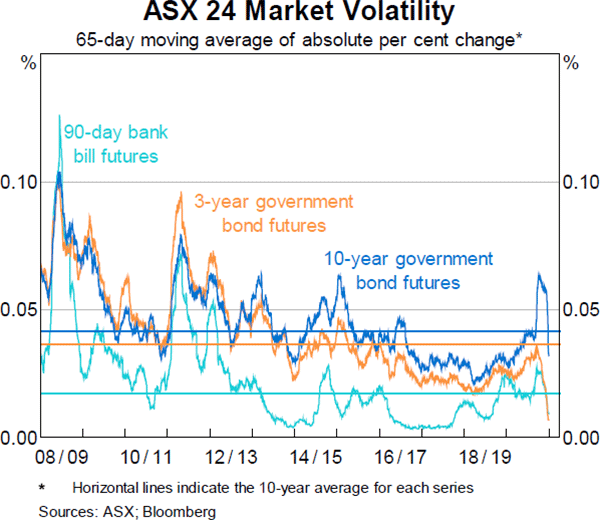
Trading activity in ETOs decreased slightly over 2019/20, while the average value and volume of cash equities traded increased, including a sharp increase in March (Graph 10). Exposures in ASX Clear increased over 2019/20. As measured by initial margin, ASX Clear's exposures in ETOs rose by 32 per cent to an average of $980 million over 2019/20 compared with 2018/19, while exposures to cash equities trades rose by 52 per cent to an average of $269 million (Graph 11). ASX Clear's exposures to the cash equities market are much lower than for ETOs primarily because of the short duration of cash market trades at two days.
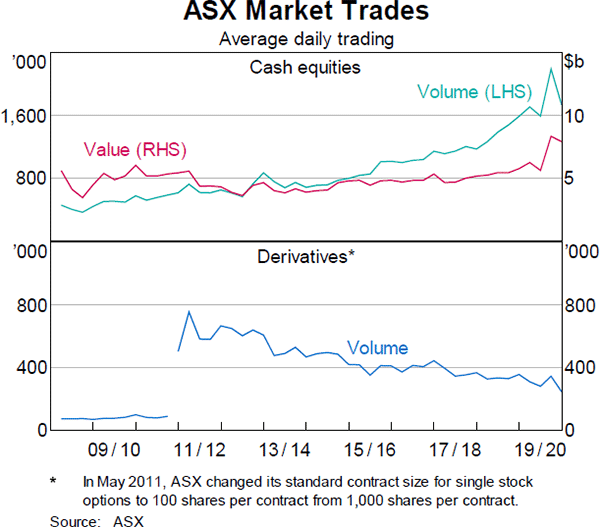
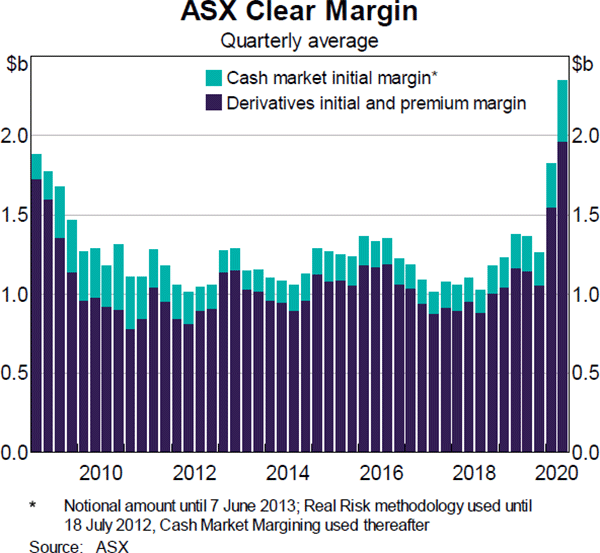
Exposures at ASX Clear (Futures) grew by 26 per cent to $7.9 billion on average, as measured by initial margin held (Graph 12). These exposures primarily arise from the four major contracts cleared – SPI 200 equity index futures, the 3-year and 10-year Treasury bond futures and 90-day bank bill futures – which accounted for around 98 per cent of total transactions cleared at ASX Clear (Futures) in 2019/20. Initial margin increased substantially in March following increases in margin rates charged on SPI 200 futures, as well as increases in margin rates for interest rate futures in late December.
Transaction volumes on ASX 24 experienced mixed growth in 2019/20, increasing across the 10-year Treasury bond futures and SPI 200 futures contracts while decreasing across the 3-year Treasury bond futures and 90-day bank bill futures contracts (Graph 13).
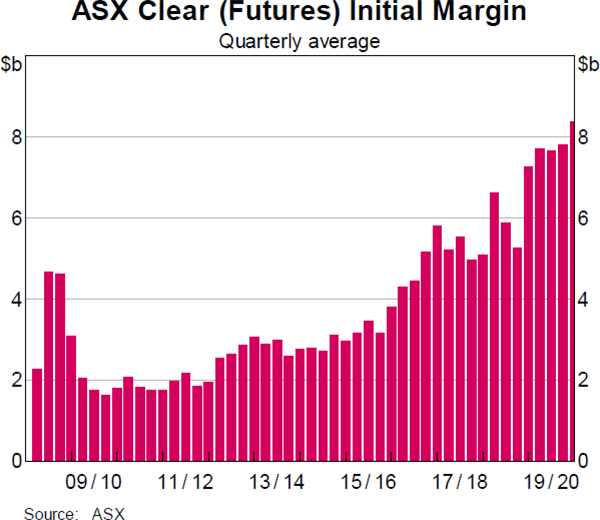
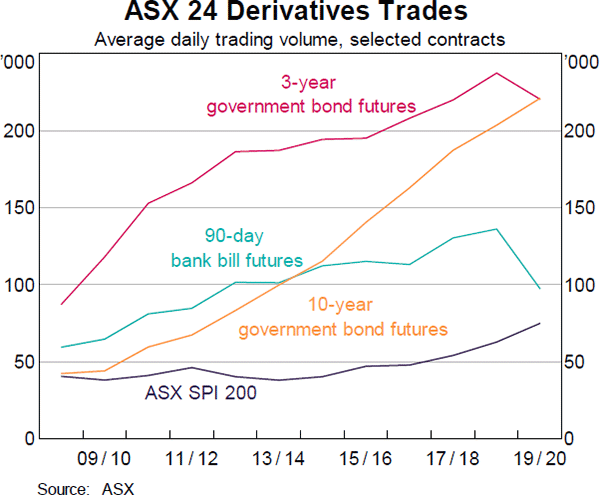
The average daily value of AUD OTC IRDs cleared by ASX Clear (Futures) increased in March before decreasing sharply over the June quarter as volatility in rates markets declined (Graph 14). Despite this decrease, the share of these products cleared by ASX Clear (Futures) increased to an average of 12.5 per cent over 2019/20.
ASX Clear had 33 direct participants as at 30 June 2020. There were 20 direct clearing participants in ASX Clear (Futures).
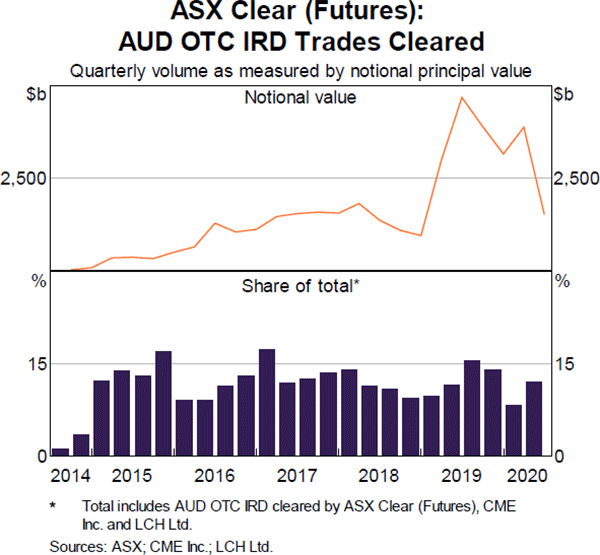
Securities settlement facilities
The daily average value of cash equity settlements in ASX Settlement increased by around 17 per cent to $12.3 billion in 2019/20. This is consistent with the growth in cash equities trading activity in the ASX market, albeit trends in net settlement values can deviate from trends in gross trading values, since the latter do not include non-market transactions and netting efficiency can change over time. Peaks in daily activity of above $35 billion occurred in March and June, well above the previous peak of $28.7 billion in March 2019 (see Graph 15). The March peak in daily activity was driven by the settlement of a record volume of 7 million cash equities trades executed across all markets.
In 2019/20, the average daily value of debt securities settled in Austraclear increased by 24 per cent, to $69.5 billion. Daily DvP transactions exceeded the previous peak of $92.2 billion on 15 occasions between March and June, with a maximum value of $113.2 billion being settled on 21 May (see Graph 16). Most of the peak days were driven by the settlement of new bonds issued by the Australian Government.
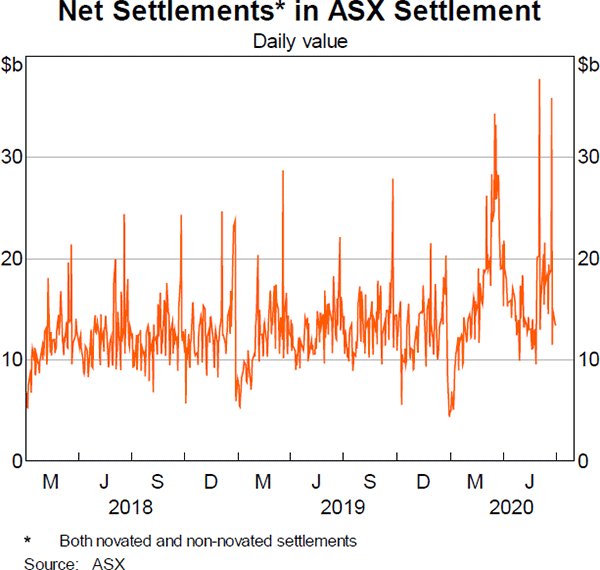
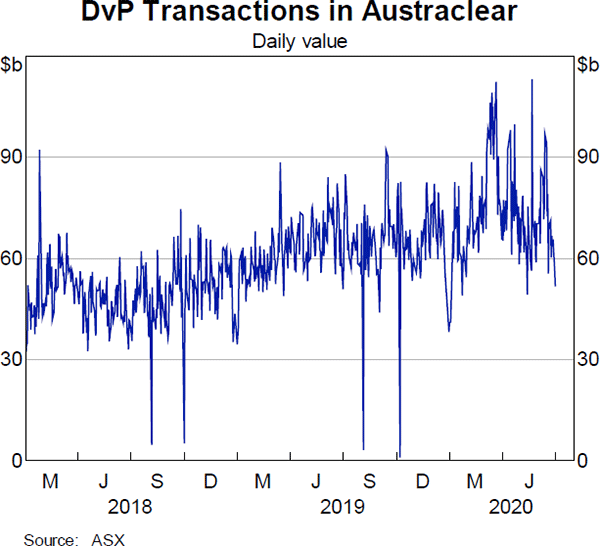
B.5 Operational Performance
ASX manages its operational risks in the context of its group-wide ERM Framework, applying consistent operational risk controls across all of its CS facilities. Key operational objectives are minimum availability of 99.8 per cent for Derivatives Clearing System (DCS) and CHESS (99.95 per cent for Austraclear, Genium and Calypso) and peak capacity utilisation of 50 per cent or less. System availability was above target availability for all systems during the assessment period (Table 7). Peak usage was at or below the limit of 50 per cent for all systems except CHESS, where peak usage exceeded 50 per cent on three days during the assessment period.
| Facility | Core system | Availability (per cent) | Peak usage (per cent) | Average usage (per cent) |
|---|---|---|---|---|
| ASX Clear | DCS | 100 | 19 | 7 |
| ASX Clear / ASX Settlement | CHESS(a) | 100 | 94(b) | 39 |
| ASX Clear (Futures) | Genium | 100 | 45 | 12 |
| ASX Clear (Futures) | Calypso | 100 | 50 | 41 |
| Austraclear | EXIGO | 100 | 49 | 26 |
|
(a) ASX's Core system is a key system supporting the submission of trades to CHESS. It was available for 100 per cent of the time, with a peak usage of 104 per cent in the assessment period. |
||||
ASX did not experience any incidents during the assessment period that impacted the availability of CS facility systems. ASX experienced two major incidents during the assessment period that impacted its CHESS system without affecting system availability. On 13 March 2020, CHESS experienced processing delays due to record volumes and a reduction in system performance. ASX was able to defer end-of-day processing of trades to allow it to make system changes to improve processing times before completing the end-of-day process on Saturday 14 March. The deferral of the end-of-day process, combined with a separate operating incident at Chi-X on 13 March, meant that the processing could not be completed until Sunday 15 March 2020.
Footnotes
For more information see The Reserve Bank's Approach to Supervising and Assessing Clearing and Settlement Facility Licensees, available at <https://www.rba.gov.au/payments-and-infrastructure/financial-market-infrastructure/clearing-and-settlement-facilities/standards/approach-to-supervising-and-assessing-csf-licensees.html>. [19]
For more information, see ‘An Enhanced Oversight Framework for Financial Market Infrastructures’, available at <http://www.rbnz.govt.nz/-/media/ReserveBank/Files/regulation-and-supervision/financial-market-infrastructure-oversight/regulatory%20developments/FMIs-Cabinet-paper.pdf?la=en>. [20]
For ASX Clear (Futures) the other collateral would include the defaulted participant's contributions to the CCP's prefunded pooled financial resources. [21]